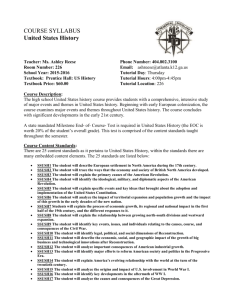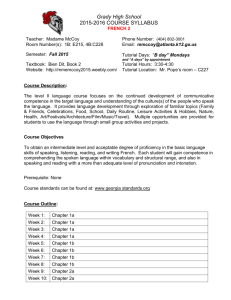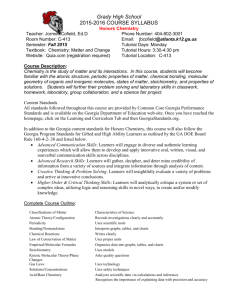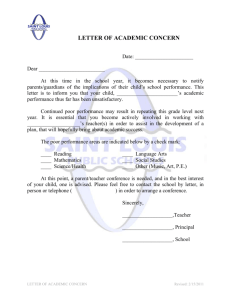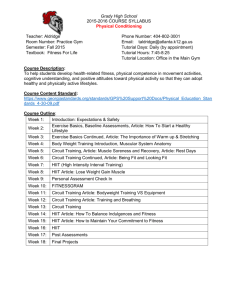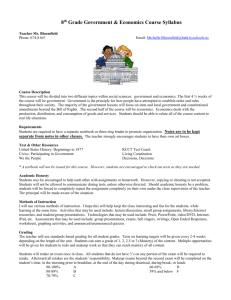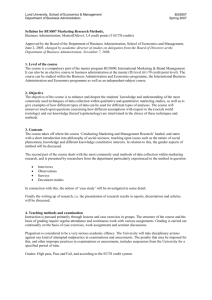Economics Syllabus - Atlanta Public Schools
advertisement
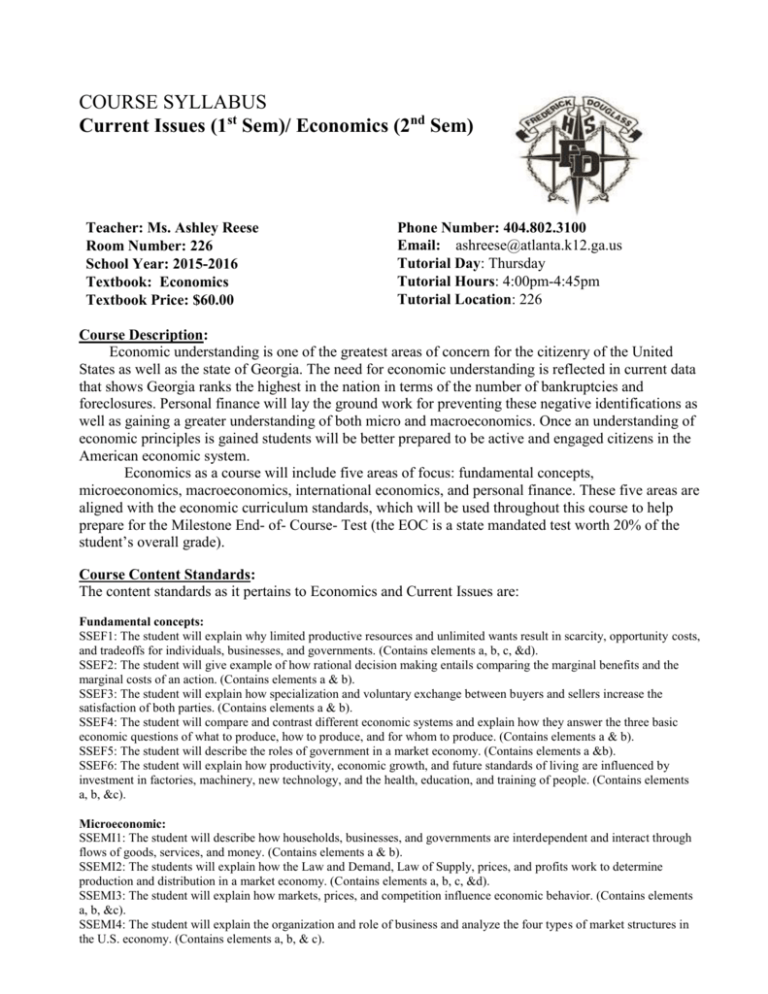
COURSE SYLLABUS Current Issues (1st Sem)/ Economics (2nd Sem) Teacher: Ms. Ashley Reese Room Number: 226 School Year: 2015-2016 Textbook: Economics Textbook Price: $60.00 Phone Number: 404.802.3100 Email: ashreese@atlanta.k12.ga.us Tutorial Day: Thursday Tutorial Hours: 4:00pm-4:45pm Tutorial Location: 226 Course Description: Economic understanding is one of the greatest areas of concern for the citizenry of the United States as well as the state of Georgia. The need for economic understanding is reflected in current data that shows Georgia ranks the highest in the nation in terms of the number of bankruptcies and foreclosures. Personal finance will lay the ground work for preventing these negative identifications as well as gaining a greater understanding of both micro and macroeconomics. Once an understanding of economic principles is gained students will be better prepared to be active and engaged citizens in the American economic system. Economics as a course will include five areas of focus: fundamental concepts, microeconomics, macroeconomics, international economics, and personal finance. These five areas are aligned with the economic curriculum standards, which will be used throughout this course to help prepare for the Milestone End- of- Course- Test (the EOC is a state mandated test worth 20% of the student’s overall grade). Course Content Standards: The content standards as it pertains to Economics and Current Issues are: Fundamental concepts: SSEF1: The student will explain why limited productive resources and unlimited wants result in scarcity, opportunity costs, and tradeoffs for individuals, businesses, and governments. (Contains elements a, b, c, &d). SSEF2: The student will give example of how rational decision making entails comparing the marginal benefits and the marginal costs of an action. (Contains elements a & b). SSEF3: The student will explain how specialization and voluntary exchange between buyers and sellers increase the satisfaction of both parties. (Contains elements a & b). SSEF4: The student will compare and contrast different economic systems and explain how they answer the three basic economic questions of what to produce, how to produce, and for whom to produce. (Contains elements a & b). SSEF5: The student will describe the roles of government in a market economy. (Contains elements a &b). SSEF6: The student will explain how productivity, economic growth, and future standards of living are influenced by investment in factories, machinery, new technology, and the health, education, and training of people. (Contains elements a, b, &c). Microeconomic: SSEMI1: The student will describe how households, businesses, and governments are interdependent and interact through flows of goods, services, and money. (Contains elements a & b). SSEMI2: The students will explain how the Law and Demand, Law of Supply, prices, and profits work to determine production and distribution in a market economy. (Contains elements a, b, c, &d). SSEMI3: The student will explain how markets, prices, and competition influence economic behavior. (Contains elements a, b, &c). SSEMI4: The student will explain the organization and role of business and analyze the four types of market structures in the U.S. economy. (Contains elements a, b, & c). Macroeconomic: SSEMA1: The student will illustrate means by which economic activity is measured. (Contains elements a, b, c, d, e, &f). SSEMA2: The student will explain the role and functions of the Federal Reserve System. (Contains elements a, b, &c) SSEMA3: The student will explain how the government uses fiscal policy to promote stability, full employment, and economic growth. (Contains elements a & b). International Economics: SSEIN1: The student will explain why individuals, businesses, and governments trade goods and services. (Contains elements a, b, &c). SSEIN2: The student will explain why countries sometimes erect trade barriers and sometimes advocate free trade. (Contains elements a, b, c, d, & e). SSEIN3: The student will explain how changes in exchange rates can have an impact on the purchasing power of individuals in the United States and in other countries. (Contains elements a, b, c, &d). Personal Finance: SSEPF1: The student will apply rational decision making to personal spending and saving choices. (Contains elements a, b, &c). SSEPF2: The student will explain that banks and other financial institutions are businesses that channel funds from savers to investors. (Contains elements a, b, c, &d). SSEPF3: The student will explain how changes in monetary and fiscal policy can have an impact on an individual’s spending and savings choices. (Contains elements a, b, &c). SSEPF4: The student will evaluate the cost and benefits of using credit. (Contains elements a, b, c, &d). SSEPF5: The student will describe how insurance and other risk- management strategies protect against financial loss. (Contains elements a & b). SSEPF6: The student will describe how the earnings of workers are determined in the marketplace. (Contains elements a & b). Course Outline: Mode of Delivery: Interactive lectures, Power Point Presentations, large and small group discussions, individual and group presentations, panel discussions, guest speakers, student-led discussions. Assessment: Students will be tested for knowledge of content using the following formats: • Traditional- multiple choice, matching, true/false, short answer, Mapping,/Diagramming, sequencing, Essay • Alternative Assessment- Project Based, Concept Applications Course Goals 1. To promote critical thinking and problem-solving skills including the analysis and synthesis of information. 2. To create an environment in which all students participate to achieve their full academic potential. 3. To learn the language of economics and exhibit an awareness of; to develop attitudes, values, and skills for citizenship in the American free enterprise system 4. To lay a foundation for life beyond high school by developing an ability to think independently and intelligently about economic problems and to create solutions. Evaluation and Grading: Course Components Classwork and Participation Homework Lesson Quizzes Unit Tests (or Performances) Projects/ EOCT TOTAL Weights 25% 10% 20% 25% 20% 100% Grading Scale 100-90 89-80 79-70 69-0 Not Evaluated A B C F NE Campus Portal for Parents: Visit https://ic.apsk12.org/portal to view class schedules, attendance records and grades. To activate your account, visit the school to receive your login (activation key). Required Materials: It is a MUST for you to have the below mentioned daily required materials. These items are needed for you to complete the days’ activities. It is not the job of your peers or teacher to issue daily materials. If daily materials are repeatedly not brought to class by a student, then that individual’s parents/guardians will be contacted. If the noncompliance of having materials continues, further disciplinary action will be requested. (Please see classroom expectations for better understanding of other possible disciplinary actions). Daily Requires Materials 1. Folder w/ 2 pockets and 3 prongs or 3 ring binder (solely for Current Issues/Economics) 2. pens and pencils 3. textbook 4. notebook paper Other Required Materials (You will be given notified if/when to bring other materials to class): 1. color pencils/ markers 2. notecards 3. rulers 4. glue Classroom Expectations: I believe all students have the ability to learn; therefore I expect all of my students to come to class well prepared with an open mind ready to participate in the class lesson. Please understand that if a student violates any of the following classroom rules then they will receive disciplinary action such as: parent phone call, parent conference, “Unsatisfactory” or “Needs Improvement” markings on report cards, teacher issued letter, or an office referral. If you do what is expected of you then you will be successful in completing this course both academically and behaviorally. Classroom Rules: • • • • • • • • • BE ON TIME everyday. Enter the classroom quietly and sit in your desk. Copy down in your notebooks all objectives written on the board. Raise your hand if you want to be addressed. No talking out of turn. Must have permission to leave the room. NO CELLPHONES or electronic devices (e.g. iPods, MP3 players, etc.) NO CHEATING of any kind on homework, test, classwork, warm- ups, and projects! NO FOOD OR DRINKS. Late Work Policy: It is important that students are responsible and meet established due dates for assignments. Late is defined as anytime work is submitted after the assignment has already been collected by the teacher. Make-up and Missing Assignments: Students with an excused absence will be expected to submit missed work on or before the third class meeting after the absence. Pre-announced assignments are due upon return to school. School- wide Expectations: MASTERY LEARNING: With mastery learning, a unit of material is taught, and student understanding is evaluated before students are able to move on to the next unit. Students who have not shown mastery for a particular unit will receive feedback and support in reaching mastery. They may be given practice exercises, study guides, group work or complementary resources to help them improve and achieve mastery. Students who demonstrate mastery of the content for a particular unit are given enrichment exercises like special projects, tasks or academic games to further or broaden their knowledge of the material. DEFICIENCY REPORTS: Parents and guardians are informed when students are making unsatisfactory progress in classes. Poor performance will be reported to parents and guardians as soon as problems are evident. Deficiency reports with plans for remediation will be written for all students making unsatisfactory progress, and parent- guardians’ conferences must be scheduled. Unsatisfactory grades should never come as a surprise to parents, guardians, or students. Teachers will: Contact parents and guardians early in the semester if academic, attendance, or behavioral difficulties are apparent. Notify the counselor, SST/RTI Chair, and the academy leader of serious problems that are affecting classroom performance. ATHLETIC ELIGIBILITY: Students wanting to participate in athletic programs governed by the GHSA and extracurricular activities must meet eligibility requirements to participate. The Athletic Director (and Extracurricular Activities sponsors) will collaborate with teachers to monitor and to identify students in danger of failing courses. All faculty members will be given a master list of students participating in extracurricular activities and athletics under the auspices of the GHSA. I________________________ have read the Economics/ Current Issues course syllabus for Ms. Reese’s class. I understand the grading scale, the classroom rules, the importance of having all required materials, and the assignment percentages of the total grade. My parents/ guardians have also read and understand the syllabus. Please Note: I will be on maternity leave from August 6th - October 2nd. I have created detailed lesson plans and assignments for the students to complete under a highly- qualified substitute during my absence. I will maintain an up- to- date grade book via Infinite Campus with the help of the substitute. The plans and assignments I have created are in line with the curriculum standards and will provide a seamless transition from the time I will be out until I return. Please contact me with any questions or concerns via email: ashreese@atlanta.k12.ga.us. ________________________ Student Signature ________________________ Parent Signature
